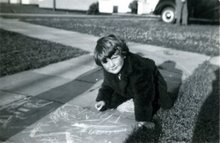
George Keen is one of the great
 us gathered the other day, courtesy of Slow Food Somerset, for a lesson from George in butter making. As luck would have it the stainless steel butter churn, which would have hidden the whole process from view, had broken down, so it was back to old fashioned methods. We were each handed a screw topped jar half filled with two day old cream, and invited to shake. If you try this yourself, don’t use very fresh cream – it won’t work.
us gathered the other day, courtesy of Slow Food Somerset, for a lesson from George in butter making. As luck would have it the stainless steel butter churn, which would have hidden the whole process from view, had broken down, so it was back to old fashioned methods. We were each handed a screw topped jar half filled with two day old cream, and invited to shake. If you try this yourself, don’t use very fresh cream – it won’t work.
There’s a lot to be said for churning your own butter in a glass jar. You can see all the various processes as they happen.
The cream thickens quite quickly and then solidifies into a lump surrounded by thin buttermilk. When you take it out of the jar it is quite granular. This is just how it should be. The next step is to wash it. You wash the butter grains in cold fresh water, which washes out the excess proteins, and then you knead the mass, adding in salt if you want some salt in your butter. Having tasted the butter with absolutely no salt in it I do think that a very little salt is a good thing for taste purposes. And it does preserve the butter.
 Next you want a pair of butter hands! These wooden paddles are soaked first in hot water, which opens the grain of the wood, and then in cold water, which closes the grain. The effect is to prevent the paddles from sticking to the butter, a bit like wetting your hands before you make meat balls. You then work the butter into pats, or blocks, or rolls.
Next you want a pair of butter hands! These wooden paddles are soaked first in hot water, which opens the grain of the wood, and then in cold water, which closes the grain. The effect is to prevent the paddles from sticking to the butter, a bit like wetting your hands before you make meat balls. You then work the butter into pats, or blocks, or rolls.



7 comments:
Your butter looks scrumptious!
We're lucky enought to live 1/2 mile from our neighbours' dairy of Jerseys & Guernseys. We dare to use their raw milk & even make our own butter when we save enough cream to make it worthwile. (I agree about the bit of salt, too.)
You must have had a lovely time. What a treat to learn from someone with such knowledge & reputation. Thank you so much for sharing!
When I was a kid we had a teacher that did all kinds of hands-on-this-is-how-things-are-really-made and the experience probably made chefs out of some of us, excellent cooks of others and the remainder slightly enlightened. We made enough butter to butter toast for the whole class. I wonder what that teacher is doing now.
Yum! I love butter but it must be all the more satisfying to taste your own.
Yum! I love butter made traditionally in small farms but to make and taste your own must be even better.
i remember our cook making real butter, just like that! i grew up next door to a dairy farm, which meant fresh, warm milk in bottles every day. with cream on top which my mother would sometimes give us over fresh fruit. delicious.
I found another butter 'recipe' on Downsizer...http://www.downsizer.net/index.php?option=com_content&task=view&id=307
How cool! I've made butter before, but in a mixer. I love that this one is truly handmade, with nothing more complicated than a jar! I'm definitely going to try this one day, when I get my hands on some good quality cream.
Post a Comment